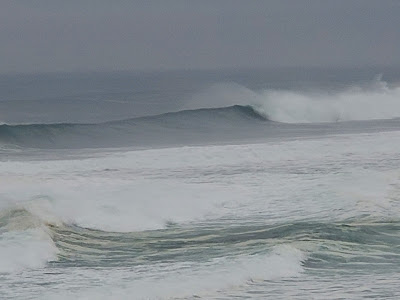Last week, the Marin Open Space District created a "shaded" fuel break along a fire road in French Ranch. They chipped and bucked a lot of trees near the road, some of which had fallen during winter storms. They took out a good number of trees in the lower grassland, before you reach the forest. It feels a lot more open and sunny now. Forest management isn't always pretty, but in a couple of years things grow back and look a lot better. And the long-term context is that over the last 40 years (with no grazing, no fires, and warmer temperatures) the woody vegetation is spreading, slowly converting the grassland to coyotebush and Douglas-fir forest. Perhaps the management goal is to revert these transitioning slopes back to a grassland? Or more likely, with work only occurring along the road, it is to give vehicles more room and safety during a wildfire.
But now imagine someone cutting down your favorite shade tree in your local park. The loss of individual shade trees on the steep hot sunny hike up to ridgetop forest makes this hike less accessible to kids and elderly and less pleasant for everyone. On a recent hike with my daughter and her friend, they were tired and we stopped to rest at one of these missing trees before heading back down. Doing that hike today would be a hotter and sunnier and less-pleasant experience.
 |
| February (left) and July (right) photos show the loss of 25-year-old shade trees on a hot south-facing slope. |
 |
| A young solitary Pacific Madrone (Arbutus menziesii) was cut down in a Marin Open Space Preserve last week. |
It has the feel of the kind of work that would be quickly done ahead of an advancing wildfire. In that situation, the loss of these trees might be more acceptable--a have-to, a lesser of two evils. Doing the work ahead of time is like buying insurance--you might need it, you might not, but you do it just in case because it is cheaper than waiting. In this case, cutting the fuel break ahead of time is more effective and better manages firefighting resources compared to waiting until a fire actually starts.
But the challenge is managing the risk of low-likelihood but high-impact events with ongoing ordinary needs and concerns. We see this risk calculation everywhere, and different people disagree on how much risk is acceptable and how much risk mitigation is necessary, especially if it impacts other values.
With natural hazards (floods, fires, earthquakes, etc.), the trade-off is usually more cost and less development in order to keep people safer. That is usually a good trade off and smart planning--unfortunately we have already permitted development in areas that should never have been developed and now are costly to protect or retreat from.
In some cases, increased development or habitat destruction is associated with risk-management. Droughts, floods, and fires can all be dealt with by throwing more money at building structures (dams, levees, fire breaks) that protect development that perhaps shouldn't be there if we had smart planning from the beginning.
This is California's dilemma--protect habitat and manage our retreat from high-hazard areas, or throw money at the problem and protect what we've already built at great cost to our treasury and environment.
In many cases, there are multiple paths forward, with a variety of alternatives available if the choice is to protect development instead of retreat. Multi-benefit solutions (like expanded floodplains and groundwater recharge) are often cheaper and more environmentally friendly and create less risk and solve other problems compared to unimaginative twentieth-century approaches (like bigger dams and levees).
The Tuolumne River is a good example. San Francisco is like a grocery store owner starving one of their children so that they can pay for insurance and sell more food. In this case, the dammed and diverted Tuolumne River, which only gets 27% of its water (in some years as little as 8%) is the starving child, the insurance is the water hoarded in Hetch Hetchy reservoir (to manage an unlikely 8.5-year drought). And water is sold to the BAWSCA member agencies while the Tuolumne River starves.
San Francisco needs to realize that the Tuolumne River is one of its kids. You'd never do this to your own child. You'd sell less food or buy less insurance instead of starving your kid. The BAWSCA agencies can invest in water recycling and become more self sufficient. Expanding water conservation (stretching resources to serve more people) is healthier for everyone, including the planet.
Different interpretations of acceptable risk will always be challenging for managers--especially when we are already overextended in a changing climate. Fire safety is sometimes a trade-off between fuel reduction and habitat. Giant solar farms in the desert (the kind of solar that big business prefers over rooftops and parking lots) are being built at a rapid pace, destroying habitat in the name of climate change mitigation. Rivers and lakes and estuaries are starved of water so that cities and agribusiness can live more comfortably through long droughts.
But we don't need to do things this way. Habitat and biodiversity are declining, and you don't want to make that worse just to have more insurance that you may not even need. Our adaptation and mitigation measures should put habitat first, protecting basic needs of ecosystems. We are creative people--we can work around those needs. We should invest in less-expensive environmentally-friendly alternative solutions before going to the costly more-destructive ones.

